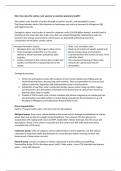EQ1: How does the carbon cycle operate to maintain planetary health?
The carbon cycle: transfer of carbon through terrestrial, oceanic, and atmospheric stores.
The fluxes between each of the elements on landscapes vary and are measured in Petagrams (Pg)
and Gigatonnes (Gt).
Geological carbon: most carbon is stored in carbonate rocks (100 000 billion tonnes), mainly found in
limestone in the ocean but also shale, clay which are created biologically. Sedimentary rocks are
formed in low-energy environments, where layers are deposited and built up over time.
Compression of the layers creates carbon.
Limestone formed in oceans: Shale, coal, and other rocks:
Himalayas form one of the largest carbon stores Made up of remains of aquatic animals and
These mountains started life as a rich ocean plants remains decay and compress.
sediment, which have been upfolded by plate Coal formed from the remains of trees, ferns
tectonics and other plants
Carbon contained in this rock has been eroded and The subsequent burning of these rocks
weather and therefore transported back to the releases the carbon back into the
oceans. atmosphere.
Geological processes:
1. CO2 in the atmosphere reacts with moisture to form weak carbonic acid, falling acid rain
slowly dissolving them, decomposing rock overtime. Then transportation via rivers to form
calcium carbonate, deposition and sedimentation turns it into limestone.
2. Subduction of sea floor under continental margins causes carbon rising up within magma
and returned to the atmosphere. Diamonds as the purest form of carbon have moved up
proving carbon deep in mantle.
3. Pockets of CO2 in earth crust, volcanic eruption and volcanic outgassing can release gas into
the atmosphere and adds further to carbon being released into the atmosphere. E.g., Mt
Pinatubo in Philippines and Yellowstone National Park in USA.
Ocean sequestration:
Earth’s 2nd largest carbon store, 50x more than the atmosphere
Biological pump: these move carbon dioxide to the ocean surface through phytoplankton as marine
plants float near surface for sunlight to photosynthesis. They convert CO2 into glucose for
zooplankton with rapid growth rates and NPP. Zooplankton release CO2 back into the ocean and
atmosphere. (Most of the carbon is recycled near the surface and 30% sinks back down to be
converted into a CO2 store).
Carbonate pump: relies on inorganic carbon sedimentation, marine organisms use this calcium
carbonate to make hard shells and skeletons etc, many dissolve before reaching sea floor and
become part of deep ocean currents.
Physical pump: oceanic circulation of carbon compounds in downwelling and upwelling.
Downwelling brings CO2 to the deep ocean (cold). Colder water = more CO2 absorbed and warmer
water = more CO2 released
, Thermohaline circulation is the global system of surface and deep ocean currents driven by the
temperature and salinity differences between different parts of the ocean. Can be seen as a giant
conveyor belt, which plays a vital part in the carbon cycle.
Main current from polar oceans, division of the main current north of Indian ocean and western
Pacific, two branches warm as they loop back around before heading to Atlantic to cool. Takes 1000
years to complete, enriched with CO2 at deeper layers
Phytoplankton sequester carbon during photosynthesis = bio pump, carbonate shells sinking to deep
water = carbonate pump and thermohaline circulation, layers on floor to build limestone, flux of
carbon from surface to ocean floor = physical pump.
Marine snow = a shower of organic material falling from upper waters to the deep ocean
Terrestrial sequestration: Storing, flux and transfer of carbon from land-based sources.
Plants sequester carbon out of
the atmosphere through
photosynthesis.
Animals consuming plants store
carbon as fat and protein and
respiration returns to carbon
back to the atmosphere.
The food chain means carbon
becomes part of the animals as
when they die carbon is released
which microorganisms can feed
on.
Two timescales of sequestration:
During the day as
photosynthesis, lower carbon
concentrations during winter.
Biological carbon: 560 gigatons in plants
Soil is largest store of carbon (20-30%), dead organic (litterfall and branch litter, shed roots) stored
before broken down and taken up by plants and released into the atmosphere.
The amount stored depends on climate, vegetation, soil type and land use.
Capacity of soil determined by climate (hot), soil type (thick and cloggy clay) and management/use
(farming).
Human intervention has enhanced this and disturbed carbon storage, cycling is faster and more CO2
being reduced due to deforestation, urbanisation (improved practices could sightly alter).
The Greenhouse Effect: importance of it regulating the earth’s temperature and precipitation,
climate driven by short wave radiation as 31% is reflected to space and 69% is absorbed by surface
and oceans.
Enhanced greenhouse effect = Human impact.
Balanced carbon cycle maintained – photosynthesis keeps CO2 levels constant and earths
temperature stable, varies spatially, NPP is highest in warm, wet areas of the world. Soil health
depends on amount of organic carbon stored, determined by inputs (dead organisms) and outputs




